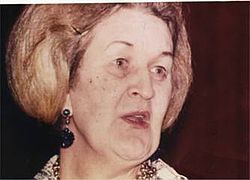- Charlotte Bach
-
Karoly Hajdu 
Charlotte Bach towards the end of her life, taken from a forthcoming documentaryBorn Hungarian Nationality Hungarian Other names Charlotte Bach Ethnicity Caucasian Known for Evolutionary Theorist Karoly Hajdu (1920–1981), later and better-known as Dr Charlotte Bach, was a Hungarian-born impostor turned fringe evolutionary theorist. In the persona of the latter, she developed an alternative theory of evolution which acquired a cult following among a number of prominent writers and scientists in the London of the 1970s. Only after her death did they discover that Bach had neither been a scientist—nor even a biological female.
Contents
Life as a man
Hajdu was born near Budapest in 1920. In the wake of World War II she moved to England, and in 1948 began to use the name Baron Carl Hajdu. In 1956 she collected money for Hungarian freedom fighters resisting the then Soviet occupation. The People newspaper, which specialised in lurid exposés, alleged that Hajdu had in fact pocketed all the proceeds. She was sentenced for fraud in 1957 and forced into bankruptcy.
Hajdu then adopted the persona of author and society hypnotherapist Michel Karoly. She rented a salubrious apartment in Mayfair, still the most expensive district in Britain. She began to acquire something of a following in polite society, and wrote an agony uncle style column in a mass-selling magazine of the day. Karoly continued in this role until 1965 when both her wife and her lover suddenly died. She became bankrupt and in 1966 she was sentenced to two months in gaol for taking out a loan whilst bankrupt.
By her own account, the sudden deaths precipitated a profound identity crisis.
Life as a woman
In 1968 Hajdu adopted the new role of Dr. Charlotte Bach, a supposed former lecturer at Budapest's Eötvös Loránd University, whose actual alumni included the philosophers Michael and Karl Polanyi and the mathematician John von Neumann.
At first, it was an episode she would refer to in her lectures occasionally as having served to provide invaluable research data—she worked as a dominatrix. She lived full-time as Charlotte Bach until she died. She was thus what is sometimes referred to as a non-op transgendered person.[1]
Human ethology
In 1971 Bach announced her new theory of evolution which, she insisted, successfully displaced Darwinism in favour of Lamarckism. Drawing heavily on the work of animal ethologists such as Tinbergen and Konrad Lorenz, she argued that humans, in varying degrees, experience a pull towards becoming the opposite sex. This urge could either be denied or asseverated: gays and femme lesbians, for example, are women in men’s bodies or vice versa, but transvestites and butch lesbians are not. This gave rise to eight possible permutations.
This deep-seated and ineradicable phenomenon, she argued, was the true engine of evolutionary change. It was also the key to the proper understanding of culture—including science, politics and religion. Upon such reasoning, backed up by a polymathic accumulation of supporting evidence and a forceful lecturing style, she constructed what she called the science of Human Ethology.
Eminent scientists who sought to engage with the apparent challenges of Bach's theory included the biologist Brian Goodwin and W. Grey Walter, a pioneer of cybernetics and former head of the Burden Neurological Institute in Bristol.
Bach attracted the interest in particular of the English writer Colin Wilson, as well as of a number of eminent British scientists and academics. Wilson began to write about her theory. Bach became a cult figure. A small group of followers who would gather at her home at Holly Lodge in Highgate, while weekly lectures would take place elsewhere. An Institute of Human Ethology was set up to promote her ideas and stimulate further research. Her literary executors included the then professor of educational technology at Britain's Open University. She was invited to speak at and Sussex University and at Darwin College, Cambridge, named in honour of the man most of whose ideas she wished to consign to the dustbin.
In due course, leading members of London's then burgeoning Gay Liberation movement—equally ignorant of Bach's true identity—took up human ethology and started publishing pamphlets of their own, much attracted by the tantalising notion of homosexuals as the vanguard of evolutionary change.
Bach continued to elaborate upon her original thesis up to the time of her death in 1981. Only then was it revealed to the faithful that Charlotte had practiced what she preached: the autopsy disclosed that she had in fact been an anatomical male.
Footnotes
- ^ Dr. Charles Moser (1999-10-10). "Addressing the Healthcare Needs of Sexual Minority Patients". Electronic Journal of Human Sexuality 2. http://www.ejhs.org/volume2/Moser/moser1.htm. Retrieved 2009-01-26.
References
- Wheen, Francis (2002), Who was Dr Charlotte Bach?, London: Short Books, ISBN 1-904095-39-9
- Wilson, Colin (1988), The Misfits: A Study of Sexual Outsiders, London: Grafton, pp. Chps 1–2, ISBN 0246129743
- Bach, Charlotte M.; Mellors, Bob (c.1985) (4 volumes), An outline of human ethology, Another-Orbit Press, OCLC 33346846, http://www.aim25.ac.uk/cgi-bin/search2?coll_id=3264&inst_id=1, retrieved 2011-09-26
External links
Categories:- Impostors
- Transgender and transsexual people
- 1920 births
- 1981 deaths
Wikimedia Foundation. 2010.
